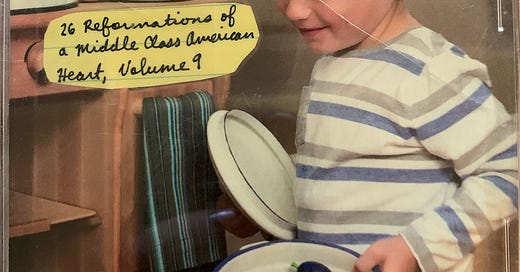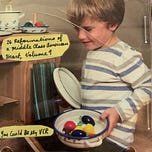Here is the track list for 26 Reformations of a Middle Class American Heart, Vol. 9: You Could Be My VCR, which I completed just prior to the Christmas holiday in 2022, in time to listen to it on the drive to New Orleans.
Side A:
Bonnie “Prince” Billy, I’ll Be Glad (2:44)
Jenny Lewis, Acid Tongue (3:54)
Stanley Brinks & The Wave Pictures, Hi, Jane (5:06)
The Legendary Pink Dots, Mailman (2:21)
Crystal Stilts, Shattered Shine (2:52)
Spiritualized, Yeah Yeah (2:28)
Sic Alps, Gelly Roll Gum Drop (3:16)
Tommy Guerrero, Zapata’s Boots (2:44)
Have a Nice Life, There Is No Food (4:00)
Paavoharju, Italialaisella Laivalla (3:50)
Blackout Beach, Astoria, Menthol Lite, Hilltop, Wave of Evil, 1982 (4:54)
The Abbasi Brothers, Clouds Are Sleeping (3:26)
Lispector, Coffee Machine (3:28)
Side B:
Mount Eerie, Climb Over (2:42)
No Age, Impossible Bouquet (2:10)
Wussy, Tiny Spiders (5:09)
Frustration, Too Many Questions (3:38)
Cut Copy, Unforgettable Season (3:13)
The Daysleepers, Space Whale Migration (3:26)
Murder By Death, ‘52 Ford (2:25)
Nick Cave & The Bad Seeds, Jesus of the Moon (3:22)
Crystal Castles, Courtship Dating (3:33)
Gang Gang Dance, House Jam (4:45)
Brent Cash, Love Is Burning Down Tonight (4:03)
Miss Lana Rebel, Blue Song (3:34)
Silver Jews, We Could Be Looking for the Same Thing (3:35)
When introducing this trilogy of genre-historical, year-specific mixtapes of indie music, I said that 2008 was the endpoint because that was the year when I grew disenchanted by the shape and direction of indie music. It’s true that that’s what happened — but it’s not because I was right to be disenchanted. In fact, making a mixtape of indie music from 2008 that claims in any way to capture the breadth of the music released that year is completely ridiculous. There is such a wealth of indie music from 2008 that I could easily fill twelve volumes of a 26 Reformations-style series with music only from that one year. And in fact, as Jay has pointed out to me, I did make a heavy round of indie-based mixtapes for him in 2008 as the year unfolded, and nothing of those mixtapes is duplicated here so far as I know (though a particularly careful observer of track lists would observe that I did include “Jesus of the Moon,” a song which Jay had previously included on a mixtape in this series).
My disenchantment was the result of suspicion about the increasing marketability and mainstream reach of indie music, rather than about the quality of the music itself. Of course in retrospect I think it’s stupid to have made any decisions about how I listened to music based on how that music was being received by others or how well it sold based on the decisions of record labels and listeners. I don’t need to waste anyone’s time here describing how and why that disenchantment formed, who it had to do with, what publications, what festivals, etc. The point is I felt that way at the time and it took making the first three volumes of 26 Reformations of a Middle Class American Heart in 2022 for me to realize that I had been looking at things wrong for more than a decade. But when I set out to make those mixes at that time, the question on my mind was, how did indie music get to a point where a megastar like Taylor Swift could make an “indie” album produced with help from The National, who last time I’d checked had been an indie rock band. That question was the curiosity that got me working in a more productive direction with my understanding of indie music.
This mix, looking back at a year which I experienced first-hand, but which I had at least somewhat misunderstood as it happened, is the conclusion of my reassessment of what had been, and what could be, indie music. When I finished it, I felt like I should be able to draw some big conclusions about what had changed for me personally and for indie music generally across the three decades these mixtapes covered. I was disappointed to find that about the only thing I could say with confidence was that indie music had grown more expansive and more various over time. Saying so isn’t saying much. But organizing the sonic record of how that has been so for me is saying a little more. And the final trilogy in the 26 Reformations of a Middle Class American Heart series, the three that follow this one, are the record of what I learned across this middle double trilogy of what indie music could be that was different from how I had conceived it originally. That will have to do for any kind of statement.















Share this post